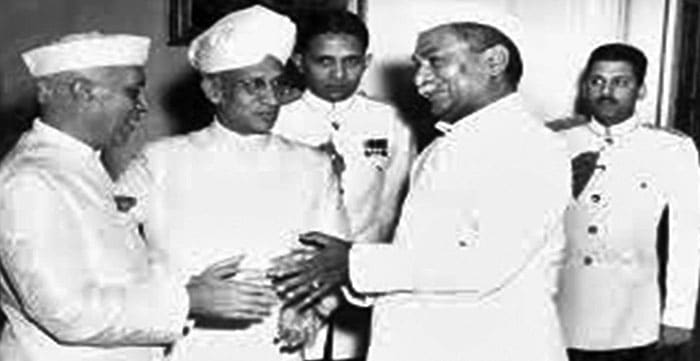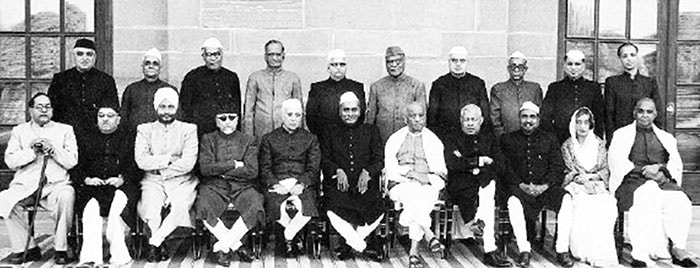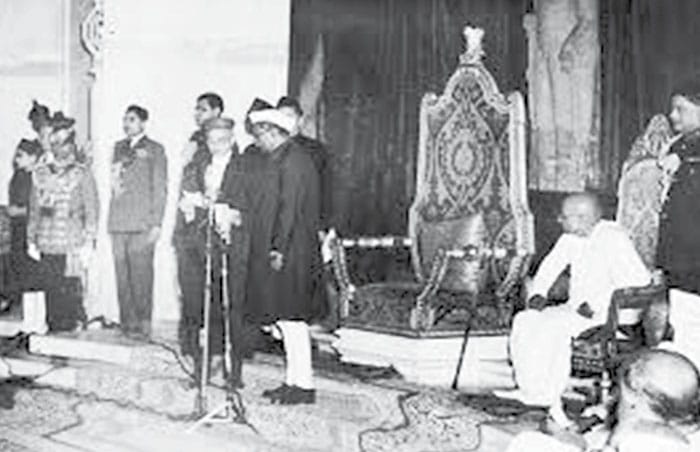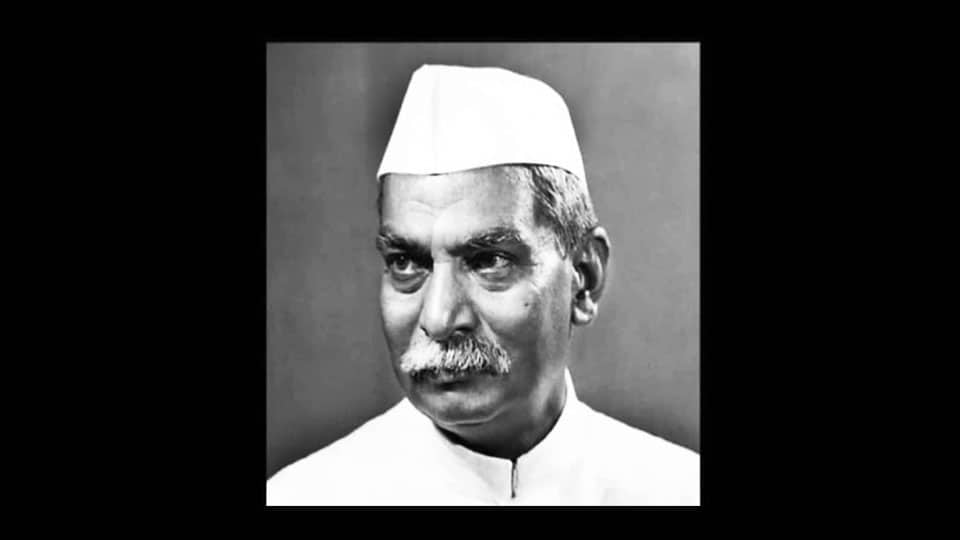By Dr. C.D. Sreenivasa Murthy
India gained independence on 15th August 1947, but technically it was not yet a fully free nation. The newly independent country had a dominion status and King George VI of Britain was its nominal head. The process of giving it a Constitution and making India a Republic had started even before the day of independence with the formation of the Constituent Assembly.
Dr. Rajendra Prasad was elected unanimously as the President of Constituent Assembly on 11th December 1946. Earlier, Dr. Prasad was a Cabinet Minister in the first Ministry of Nehru formed before independence. With his pleasant countenance, patience and deft handling of the Constituent Assembly as its President, he had won the admiration of the Congress party and the Indian public. He was called “Ajatha Shatru,” a person with no enemies. The Constituent Assembly adopted the newly framed Constitution of India on 26th November 1949.
Dr. Rajendra Prasad was born in a landed kayastha family on December 3, 1884, at Zeradei, a village in Bihar. He was a brilliant student and obtained his legal degree and later a Doctorate in Law from Calcutta University. He was very successful and had a lucrative legal practice at Calcutta and Patna High Courts.
Dr. Prasad was drawn early into the non-cooperation movement for independence, became a comrade of Mahatma Gandhi and was imprisoned a number of years during the freedom movement. He was President of the Indian National Congress during the years 1934, 1935 and 1939. Dr. Prasad was a devout religious person who had great respect for the ethos and traditions of Hinduism.

Pandit Nehru and Dr. Prasad were poles apart in their outlook and this brought them into conflict many times. Nehru was a secularist, socialist and never practiced the rituals and traditions of Hinduism while Dr. Prasad was a staunch Hindu deeply entrenched in the beliefs and traditions of religion. The major public confrontations between Nehru and Prasad started, even before the birth of Indian Republic, with the Hindu Code Bills.
Dr. Bhimrao Ambedkar presented the draft in October 1947 in the Constituent Assembly and Nehru strongly supported the Bill. They wanted this Bill to be part of the Constitution. Under this, a rule code for all Hindus was to be created. As the President of the Constituent Assembly, Dr. Rajendra Prasad intervened. He believed religion in the society is equally important as anything else and wanted to have a Uniform Civil Code for all Indians whereas Nehru strongly felt minorities should be given additional safeguards against Hindu majority. Furious with Nehru’s attitude, Dr. Rajendra Prasad wrote a letter to him. In the letter, he described Nehru as unjust and undemocratic.
Dr. Prasad shared the letter with Sardar Vallabhbhai Patel before sending it to Nehru. Patel read the letter and suggested that he not act angrily, to withhold the letter and to raise his disagreement in the Party’s forum. Dr. Rajendra Prasad was unhappy with this advice of Patel, but followed it and kept back the letter. Patel was a shrewd politician and had his own future plans for Prasad. The debate on the Code Bill spread all over the country and conservative religious leaders opposed it vigorously. Nehru noticed the controversy surrounding the Bill and at the time when the Constitution was to be filled with the Hindu Code Bill, he took a tough stand.
It was already September 1949; the Constitution was about to be completed and the Presidential election was to be held soon after. Patel and the Congress party wanted Rajendra Prasad to be the President. Nehru, at that time, favoured the then Governor General Rajagopalachari to be the first President of the nation. Chakravarthi Rajagopalachari had not participated in the Quit India Movement and hence was not popular with the Congress party cadre. Patel and Prasad had a strong hold on the organisation, even more than Nehru. Congress party chose Rajendra Prasad as the President of India. The Constituent Assembly elected Dr. Rajendra Prasad as the first President of India unanimously.
At the most solemn ceremony, held in the brilliantly lit and high domed Durbar Hall of the then Vice Regal Palace (present day Rashtrapati Bhavan), India was declared a Sovereign Democratic Republic exactly at eighteen minutes past ten on the morning of Thursday, January 26, 1950. The retiring Governor-General, C. Rajagopalachari, read out the proclamation of the Republic of “India, that is, Bharat.” On January 26, 1950, at 10.24 am, Rajendra Prasad created history by becoming the first President of the new Republic. Justice Harilal Jekisundas Kania, the first Chief Justice of the Supreme Court of India, administered the oath of office. The birth of the Indian Republic and the installation of its first President were announced by a salute of 31 guns shortly after 10.30 am. Prasad’s sister, Bhagwati Devi, had died the previous day, 25th January, and he attended her cremation after the founding of the Republic and swearing-in ceremony.
The famous Somnath temple, which was in Junagadh State before independence, was known for its splendour and wealth in ancient times. It was first plundered and destroyed by Ghazni Muhammad in 1025, and subsequently rebuilt many times and repeatedly looted by foreign invaders. After India’s Independence and the accession of Junagarh State into Indian Union, Sardar Vallabhbhai Patel, the then Union Home Minister, pledged that Somnath should be reconstructed and restored to its original glory.

When Patel broached this subject with Mahatma Gandhi, Gandhiji endorsed the plan but said that the contribution for the reconstruction of the temple should come from the public and not the Government. With the demise of Patel, the task of the restoration of the temple was ably led by K.M. Munshi, a famous lawyer, author, founder of Bharatiya Vidya Bhavan (BVB) and a Cabinet Minister in the Prime Minister Jawaharlal Nehru’s Government.
Nehru never liked the idea of restoring this ancient monument and more than once criticised Munshi for its reconstruction. At the end of a Cabinet meeting, Nehru called Munshi and said: I don’t like your trying to restore Somnath. It is Hindu revivalism. Munshi did not utter a word but later wrote to Nehru a long letter saying, “…. It is my faith in the past which has given me the strength to work in the present and to look forward to our future. I cannot value freedom if it deprives us of the Bhagavad Gita or uproots our millions from the faith with which they look upon our temples and thereby destroys the texture of our lives…. this shrine once restored to a place of importance in our life will give to our people a purer conception of religion and a more vivid consciousness of our strength.”
When the then President of India, Dr. Rajendra Prasad, was invited to inaugurate the temple, Nehru advised the President “against participating in a significant function which unfortunately has a number of implications.” Dr. Rajendra Prasad ignored Nehru’s advice and added, “I would do the same with a mosque or a church if I were invited.”
So, on 11th May 1951, Dr. Rajendra Prasad, while presiding over the opening ceremony of the temple, gave a stirring speech. He said that “the physical symbols of our civilisation maybe destroyed, but no arms, army or king could destroy the bond that the people had with their culture and faith. Till that bond remained, the civilisation would survive.” He added that it was the creative urge for civilisational renewal, nurtured in the hearts of the people through centuries that had once again led to the “praan-pratishta” of the Somnath deity. Somnath was the symbol of economic and spiritual prosperity of ancient India, he said. The re-building of Somnath will not be complete till India attains the prosperity of the yesteryear.” In anger at the President’s defiance of his wishes, Nehru instructed the Information Ministry not to officially publish the speech. But the newspapers all over the country widely reported the speech.
Sardar Patel, the Deputy Prime Minister who unified the 564 States into the Indian nation, was a dear friend of the President. Patel died at Bombay on 15th December 1950. Nehru advised the President against attending the funeral of Sardar Patel citing protocols. Dr. Prasad rejected this advice of the Prime Minister and went to participate in the funeral services of his close associate and the great freedom fighter.
The first general elections held in 1952 was the first major milestone for the infant Republic. While the world watched skeptically, Indian elections with the universal franchise and the biggest electorate in the world went on peacefully, and a democratically elected Government was installed in New Delhi. Congress got a spectacular majority under Nehru’s leadership.
With the death of Patel, Nehru had emerged as the undisputed supreme leader of India. After the general election, the electoral college was to elect a new President. Against the wishes of Nehru, the Congress party nominated Dr. Rajendra Prasad once again for the President. Nehru in full control of the Congress party after the 1952 elections to Parliament, easily got the Hindu Code Bills passed and President Prasad, as a true democrat, signed those Bills into law without any protest.
While he accepted the party’s will in 1952, in the elections of 1957, Nehru had the opportunity to elect the President of his own choice. So, this time, his favourite was the first Vice-President Dr. Sarvepalli Radhakrishnan. Dr. Radhakrishnan was a philosopher, sanskrit scholar, prolific writer, Spalding Professor of Eastern Religions and Ethics at the University of Oxford, and a former ambassador to the Soviet Union. To the utter disappointment of Nehru, the choice of the Congress party once again was Dr. Rajendra Prasad who was easily elected. Dr. Radhakrishnan was very upset and desired to resign. To placate him, Nehru changed the order of precedence. Previously the order was President, Prime Minister and the Vice-President. He made the Vice-President second, demoting himself to the third position. Dr. Prasad is the only President in Indian history to have occupied Rashtrapati Bhavan for twelve long years.

The nation’s greatest honour ‘Bharat Ratna’ is always awarded after recommendation from the Prime Minister and the Union Cabinet. On July 13, 1955, Nehru had returned from a successful tour of European countries and the Soviet Union, a tour aimed at the promotion of peace as the Cold War was rapidly escalating. Nehru’s efforts to establish India as a major player in world affairs found popular support outside India. On Nehru’s return to Delhi, the then President of India, Dr. Rajendra Prasad, went to the airport to receive him, disregarding protocol. He also hosted a special State banquet on July 15, 1955, at Rashtrapati Bhavan in honour of Nehru. It was at this event that Dr. Prasad announced his intention of conferring the ‘Bharat Ratna’ upon Jawaharlal Nehru. Dr. Prasad described Nehru as the ‘great architect of peace in our time’. The President himself confessed that he had acted unconstitutionally as he had decided to confer the honour “without any recommendation or advice from my Prime Minister or the Cabinet.”
Nehru always viewed the first President as a revivalist who did not represent the new India. Though there were many invitations from foreign nations, the Prime Minister rarely allowed him to go for official visits as head of State. Dr. Rajendra Prasad and Nehru, in spite of their strong differences, admired and respected each other. President Dr. Prasad was a true Gandhian and believed in simple living. The official salary of the President was ten thousand rupees per month. But he drew only five thousand. After he demitted office in 1962, he did not stay in Delhi, but went to live in Sadaqat Ashram in Patna. He donated all the jewels of his wife to the National Defence Fund at the time of war with China. India’s highest honour ‘Bharat Ratna’ was conferred on him in 1962. He died on 28th February 1963. Nehru did not attend the funeral and went away on a tour of Rajasthan. He also dissuaded President Dr. Radhakrishnan from attending, but the President did not heed his advice and travelled to Patna for the last rites of the deceased former President.
The first President’s contribution to the freedom movement and the stabilisation of Indian Democracy were immense. He steered the proceedings of the Constituent Assembly sagaciously and helped the unanimous adoption of the Indian Constitution. Dr. Prasad established good democratic traditions during the twelve long years he occupied the Rashtrapati Bhavan. He was a simple, elegant, unostentatious person and conducted himself with humility and dignity. Dr. Babu Rajendra Prasad was a Great President.
Note: The shadow boxing among political giants of those days Nehru, Dr. Rajendra Prasad and Dr. Radhakrishnan was understandable. A Uniform Civil Code, as contemplated in the Constitution, may help set right the defects or deficiencies Nehru found in the customs and practices of majority Hindus and also in other minority communities. It is gross discrimination and injustice not to have a statue or a memorial to such great leaders like Dr. Rajendra Prasad, Vallabhbhai Patel, Subash Chandra Bose and P.V. Narasimha Rao in Delhi, who had by their political genius and leadership qualities changed the course of country’s destiny for the better — reclaiming its past religious glory, achieving unity of a fragmented nation and a critical course-correction in its economic policy.—Ed








I remember studying in my middle school years, that he visited Mysuru in mid-1950s , particularly to talk to the scholars in Maharaja’s Sanskrit College, and to inaugurate an event. I heard from my relatives who worked there that he spoke to them fluently in Sanskrit.
He was more of an intellectual, a scholar and so too his successor Servepalli Radhakrishnan , as both were not politicians. Both were honest and had scruples.
If Rajagopalachari had become the president instead of Rajendra prasad, , many thought, he as a wily and strong minded criminal lawyer in his earlier life, would not have tolerated many failures of Nehru- of which there were many, as independent India was going through rough patches then with problems galore, and he would have dismissed Nehru as the PM,
One cannot but wonder that that those days had m en of gravitas to fill in the top leaderships of the country.
Compare them with the current pygmies; There is president Kovind ( is it Govind, twisted to sound different?), who appreciates Tipu Sultan the Muslim thug who imprisoned the legitimate ruler-the Wadiyar, and Modi who was roaming around the world with tailor made good dresses, taking selfies with Zuckerberg and promising digital India, which even if materialsed fully, will not m\make India as a world power, except as a third world outsourcing destination cesspit with cheap Indian IT techies servicing the rich clients like Zuckerberg. Or the pick of the Turin barmaid Sonia or his fat university drop out son Rahul who achieved zilch.
One cannot but wonder that that those days had m en of gravitas to fill in the top leaderships of the country.
Compare them with the current pygmies; There is president Kovind ( is it Govind, twisted to sound different?), who appreciates Tipu Sultan the Muslim thug who imprisoned the legitimate ruler-the Wadiyar, and Modi who was roaming around the world with tailor made good dresses, taking selfies with Zuckerberg and promising digital India, which even if materialsed fully, will not m\make India as a world power, except as a third world outsourcing destination cesspit with cheap Indian IT techies servicing the rich clients like Zuckerberg. Or the pick of the Turin barmaid Sonia or his fat university drop out son Rahul who achieved zilch.
Nehru and his chmchas in Congress are anti Hindus and brought out the draconian laws to control Hindu Temples and funds. They lacked courage to do the same to other religions and control their funds. This hypocrisy is the reason we are still divided.